The Pine Tree Mound exhibit was written by Ross Fields and Eloise Gadus of Prewitt and Associates, Inc., of Austin. Susan Dial and Heather Smith developed the exhibit for the web. Graphics were drawn by Sandy Hannum and Brian Wootan of Prewitt. The colorful reconstructed scenes of Caddo life that enrich this exhibit are from paintings by Nola Davis, courtesy of Texas Parks and Wildlife, Reeda Peel, and George Nelson.
The archeological project was unusual in many regards. In the view of the Prewitt staff, few archeologists have the opportunity to excavate a site that is as important to a particular culture or group as Pine Tree Mound is to the Caddo. The individuals and groups who contributed are recognized below.
Prewitt and Associates, Inc.
Ross C. Fields was the principal investigator from the inception of the project to its completion. His understanding of and great curiosity about the archeology of northeast Texas shaped the scope and direction of the research and was key to linking the Pine Tree Mound site to its rightful place in Caddo history and prehistory. He is the president of Prewitt and Associates, Inc., an Austin-based firm that provides archeological and historical consulting services to federal and state agencies, local governments, private industry, and individuals. He holds bachelor's and master's degrees in anthropology from the University of Texas at Austin. Before joining Prewitt and Associates as a Staff Archeologist in 1981, he honed his archeological skills on a variety of projects in places such as east Texas, northeastern Oklahoma, southeastern Alaska, and the Four Corners region of the Southwest. Although he has worked on a variety of projects throughout Texas, his strongest research interests lie in east Texas, having been fostered by a 1975 field school with Dee Ann Story at Deshazo, a protohistoric Caddo hamlet west of Nacogdoches, and work in 1977 and 1980 at the George C. Davis site.
Eloise Frances Gadus was the project archeologist for the 2006–2007 excavations. She collaborated with Fields in analyzing the data recovered and writing the exhibit. Her interest in symbols as a means of understanding how people view their world brought a fresh perspective to study of the pottery and analysis of the mortuary remains for this project. A research archeologist who has worked for Prewitt for over 20 years, she is an expert in the prehistoric Native American societies of east Texas and the Gulf Coast. This interest grew out of her undergraduate research assistantship at the Cleveland Museum of Natural History of Ohio where she was introduced to the prehistory of the Southeastern United States. She also gained experience in the field of Cultural Resource Management by working for the University of West Florida at Pensacola in both Florida and Mississippi and from her graduate studies at the University of Florida, Gainesville
The Caddo Nation of Oklahoma
The Pine Tree Mound site has been a place of great significance to the Caddo people for hundreds of years. The Caddo Nation of Oklahoma has been instrumental in helping exploration of their past go forward. This exhibit is but one version of the story of the Nadaco Caddo in northeast Texas, and it is offered in a spirit of respect for the rich traditions of the Caddo people. In that spirit, North American Coal Corporation–Sabine Mine coordinated this project with the Caddo Nation through Tribal Historic Preservation Officer Robert Cast and NAGPRA Coordinator Bobby Gonzalez. Caddo elder Lyman Kionute visited the site with Cast and Gonzalez in 2006 to lend his understanding of the importance of the site. After the fieldwork was finished, representatives from the North American Coal Corporation–Sabine Mine, American Electric Power, and Prewitt and Associates, Inc., traveled to the Caddo Nation headquarters in Binger, Oklahoma, and presented the initial project findings to the Tribal Council then chaired by LaRue Parker. Coordination for repatriating the people disinterred from the site during the excavations was done by the Sabine Mine through Gonzalez and Cast.
North American Coal Corporation–Sabine Mine
The North American Coal Corporation’s Sabine Mine produces lignite to operate the H. W. Pirkey Power Plant nearby. The plant is operated by American Electric Power (AEP), which was the ultimate funding source for the project. AEP’s commitment to the project extended well beyond funding the archeological work, however; they also volunteered to purchase part of the site and donate it to the Archaeological Conservancy for preservation. The project would not have had the positive outcomes it did without the determination of Sabine Mine and AEP to meet and exceed their regulatory requirements. For Sabine Mine, Marty Walker, Roger Fish, Randy Harris, and Phil Berry successively served as Environmental Manager and oversaw the work. For AEP, Ken Howsen and Greg Shurbet played key roles in pushing the project forward and ultimately getting part of the site preserved.
The Archaeological Conservancy
The Archaeological Conservancy is a national nonprofit organization that acquires and preserves some of the nation’s most important archeological sites. Dr. Dee Ann Story, a pioneering Texas archeologist, was on the Conservancy’s board of directors when work started at Pine Tree Mound. She was instrumental in alerting the Conservancy to the value of the site, and the Conservancy’s Jim Walker and Amy Espinoza understood the need to move quickly to protect the remainder of the site once mining operations were complete. Their acceptance of the task of managing the property in trust means that the Pine Tree Mound site will always remain a special place. To honor her part in preserving the site, the Conservancy named their preserve there for Dr. Story.
Print Sources
Bruseth, James E., and Nancy A. Kenmotsu
1993 From Naguatex to the River Daycao: The Route of the Hernando de Soto Expedition through Texas. North American Archaeologist 14(3):199–225.
Carter, Cecile Elkins
1995 Caddo Indians: Where We Come From. University of Oklahoma Press, Norman.
Chafe, Wallace
1993 Caddo Names in the de Soto Documents. In The Expedition of Hernando de Soto West of the Mississippi, 1541–1543: Proceedings of the De Soto Symposia, 1988 and 1990, edited by Gloria A. Young and Michael P. Hoffman, pp. 222–226. The University of Arkansas Press, Fayetteville.
Fields, Ross C., and Eloise Frances Gadus (editors)
2012 Archeology of the Nadaco Caddo: The View from the Pine Tree Mound Site (41HS15), Harrison County, Texas. Report of Investigations No. 164. Prewitt and Associates, Inc., Austin.
Fields, Ross C., and Eloise Frances Gadus
2012 The Pine Tree Mound Site and the Archeology of the Nadaco Caddo. Bulletin of the Texas Archeological Society 83:23–80.
Griffith, William J.
1954 The Hasinai Indians of East Texas as Seen by Europeans, 1687–1772. Publication 12. Middle American Research Institute, Tulane University, New Orleans.
Jones, Buddy C.
1968 The Kinsloe Focus: A Study of Seven Historic Caddoan Sites in Northeast Texas. M.A. thesis, Department of Anthropology, University of Oklahoma, Norman.
|
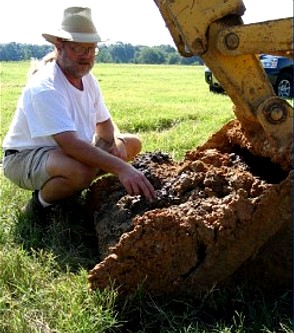
Ross C. Fields at the Pine Tree Mound site in 2004.  |
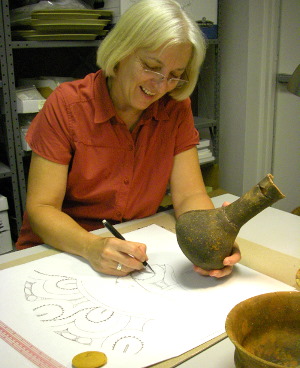
Eloise Frances Gadus studying pottery from the Pine Tree Mound site.  |
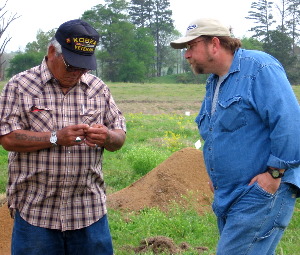
Caddo elder Lyman Kionute and Tribal Historic Preservation Officer Robert Cast at the Pine Tree Mound site in 2006.  |
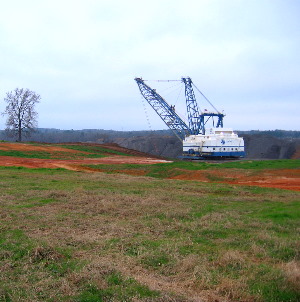
Dragline removing overburden during lignite mining in the Potters Creek valley just west of the Pine Tree Mound site.  |
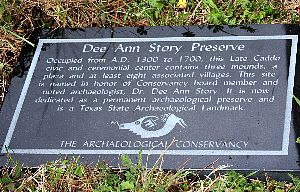
Photograph of the Archaeological Conservancy marker honoring Dr. Dee Ann Story.  |
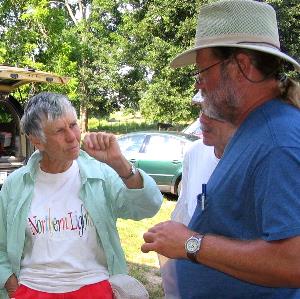
Dr. Dee Ann Story at the Pine Tree Mound site in August 2004 explaining to Ross Fields and others what some of the site testing results might mean.  |
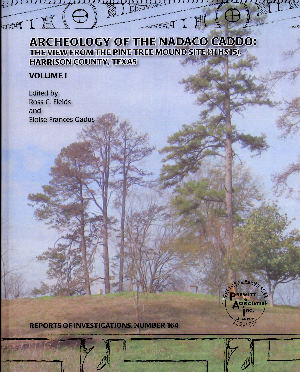
Cover of Volume 1 of the Pine Tree Mound report by Prewitt and Associates, Inc.  |
|






